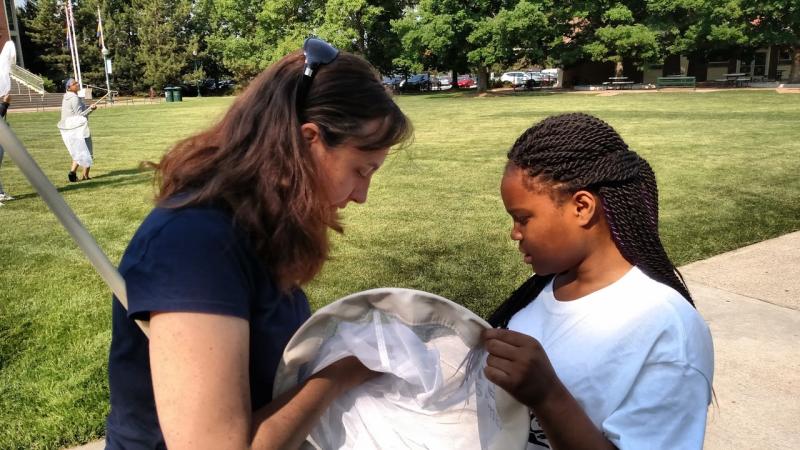Shannon Murphy Awarded NSF Grant for Insect Research

DU associate professor Shannon Murphy teaching a middle-school student to use an insect net.
“There are 10 times more butterflies and moths out there than all of the birds and mammals you can think of,” says Shannon Murphy, associate professor of biology at the University of Denver's College of Natural Sciences and Mathematics.
But while science has diligently categorized diversity among beetles, moths and flies, it still hasn’t brought us closer to understanding just why and how insects have evolved into such a wide variety of species.
Through a new grant awarded by the National Science Foundation (NSF), Murphy, along with post-doctoral fellow Dhaval Vyas and collaborators at Georgetown University and University of Massachusetts Boston, will spend the next four years considering this puzzle and working to understand the role diet plays in insect diversity.
Of the many herbivorous insects inhabiting our homes, gardens, farms and forests, about 90% are considered “specialists,” meaning they have tailored their diets to only a single or very few plant species. Take monarch butterflies, for example. Milkweed, their favorite meal as caterpillars, has defenses such as latex sap and toxins that prevent most insects from digging in. Monarchs, however, have evolved to withstand these defenses and have tailored their diets around this plant. They even co-opt its chemical defenses to protect themselves from predators.
The remaining 10% of insects are considered generalists. They eat whatever is available and tasty, despite the many deterrents plants devise (so-called bottom-up effects) and the additional impact of natural enemies, such as predators and parasitic insects (top-down effects). For years, ecologists have disagreed over whether bottom-up effects have the greater influence on insect diets or whether top-down effects do.
“This grant is to figure out how top-down and bottom-up interactions affect insects with a broad diet differently than those with a narrower diet,” Murphy says. Working with Vyas and a number of undergraduate students, Murphy will employ fall webworm caterpillars, a moth species she’s worked with for over a decade, to reveal new insights about insect diets.
“What we have found is that fall webworms have this huge range in diet breadth. They can eat over 400 species of plants worldwide. But here in Colorado, there are some populations that eat only two to four species, some eat 15 species, and then out east there are other populations that eat a lot more,” Murphy explains. “So, we are looking to see how the plants and natural enemies may be driving the evolution of diet breadth.”
This research doesn’t just seek to answer an important question that has intrigued scientists for decades. It also aims to provide information very useful to the agricultural industry.
“Many of our worst pest insects on agricultural crops are generalists,” Murphy says. “Some are also specialists, but many are generalists. So how do they eat so many different host plant species? We don’t really know that right now.”
Beyond the lab, Murphy plans to put insects to work in the classroom. As part of the grant, she and Vyas will bring their research and passion for science to students all the way from kindergarten to graduate school.
Elementary students will get up close and personal with fall webworms and other caterpillar species through Murphy’s “Caterpillar Road Show,” designed to encourage an early passion for science.
“A lot of students, especially when they are younger, feel that you only see a lot of really cool animals on nature shows if they are in Africa or the Amazon,” Murphy says. “Here we are showing them, ‘Look at all the really cool things that are in your own backyard.’”
The grant also creates scholarships for four girls to attend DU Sci-Tech, a summer camp for middle-school-age girls, cofounded by Murphy and two other DU professors, Robin Tinghitella and Jennifer Hoffman.
These educational aspects of the NSF grant address Murphy’s concern about the challenges facing young girls interested in STEM.
“I feel really strongly that a lot of our diversity problems that we have in STEM at these higher levels are because we have lost people in the pipeline all the way through,” she explains. “There’s a lot of research that says middle-school girls in particular feel they cannot express their interest in STEM without being ridiculed.”
This work, much like her research, has not gone unnoticed. Just this summer, Murphy received the Distinguished Achievement Award in Teaching from the Entomological Society of America — her first national teaching award.


